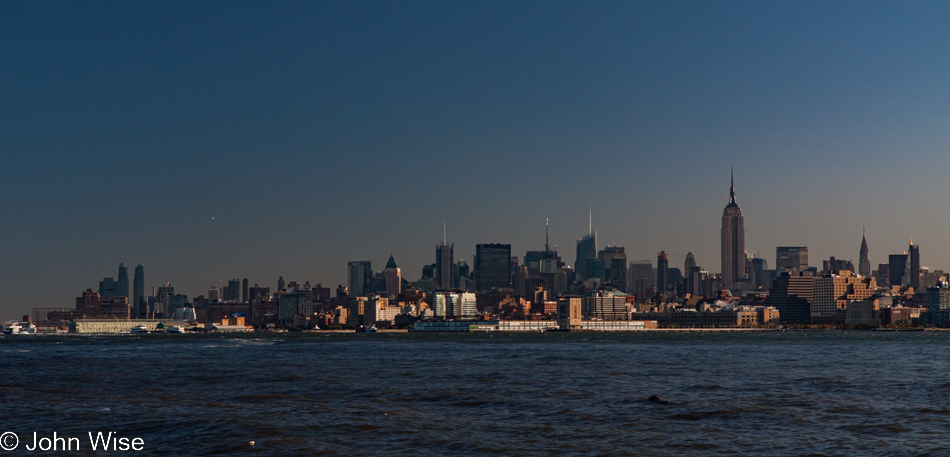
It was just five months ago that we were last here, 2,400 miles from home, looking at the exact same view, except that we were traveling with my mother-in-law, Jutta Engelhardt. She’d never been to New York City, and neither Caroline nor I had been to the Statue of Liberty. Back on the 23rd of May, we spent a good amount of time visiting Ellis Island before continuing to Liberty Island, where the Lady stands. We couldn’t visit the statue’s interior then as we didn’t have reservations, and the crown was still closed as it had been for ten years.
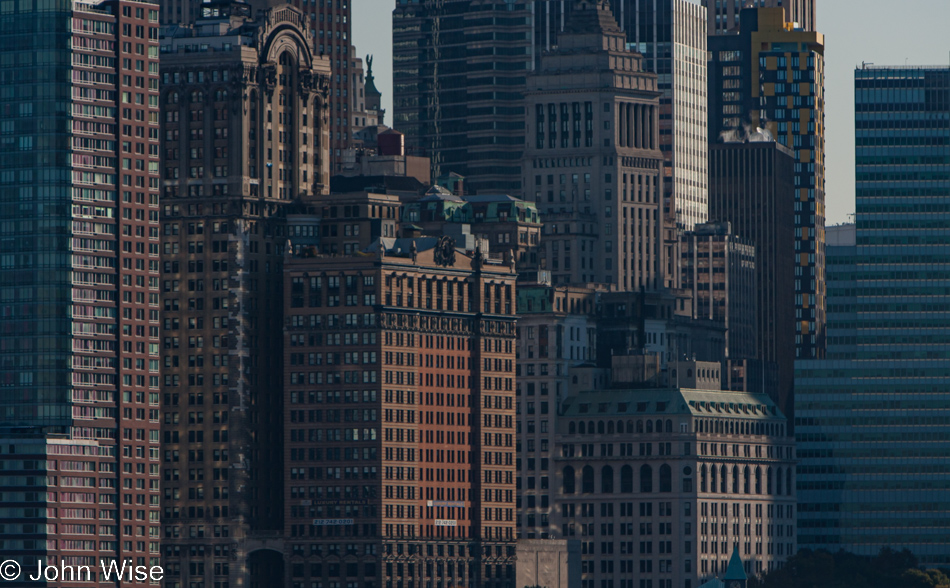
But we learned on that day the crown would be reopening for a short period starting on July 4th, so we made plans. So, this is the primary reason we’ve been back here in the northeastern United States on this vacation.
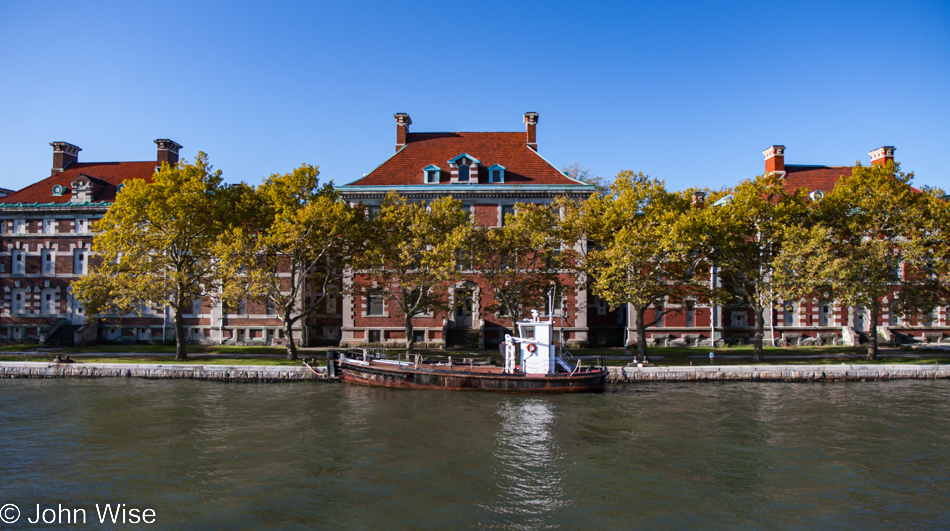
Having recently had a great tour of Ellis Island, we don’t feel any need to spend any more time there on this visit.
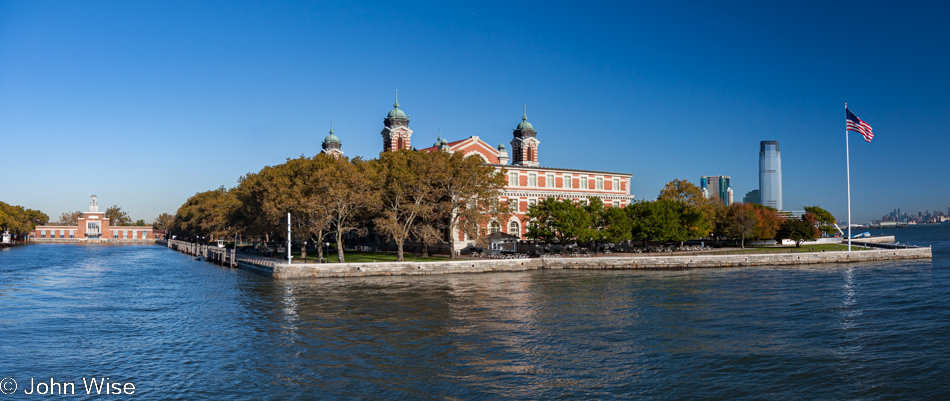
This, though, is where the ferry to Liberty Island departs, and so for a few minutes, we were once again on this small bit of land in New York Harbor.
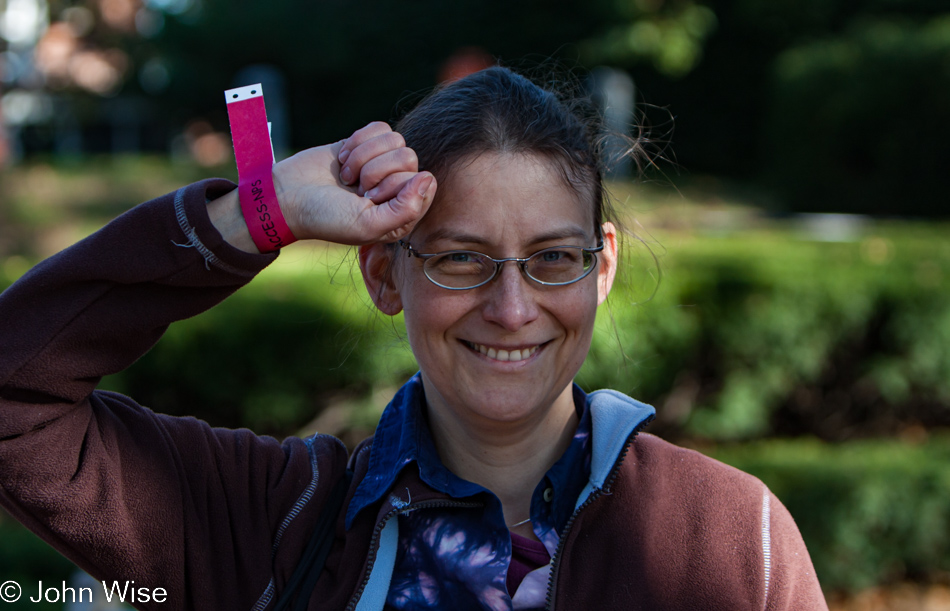
That is the look of, “Oh my god, we have the special wristbands that will actually allow us to visit the Crown of the Statue of Liberty!” This is an incredible honor, and we are fortunate beyond belief as only about 500 people a day on the best of days are granted permission to make their way to the top of the Statue of Liberty.
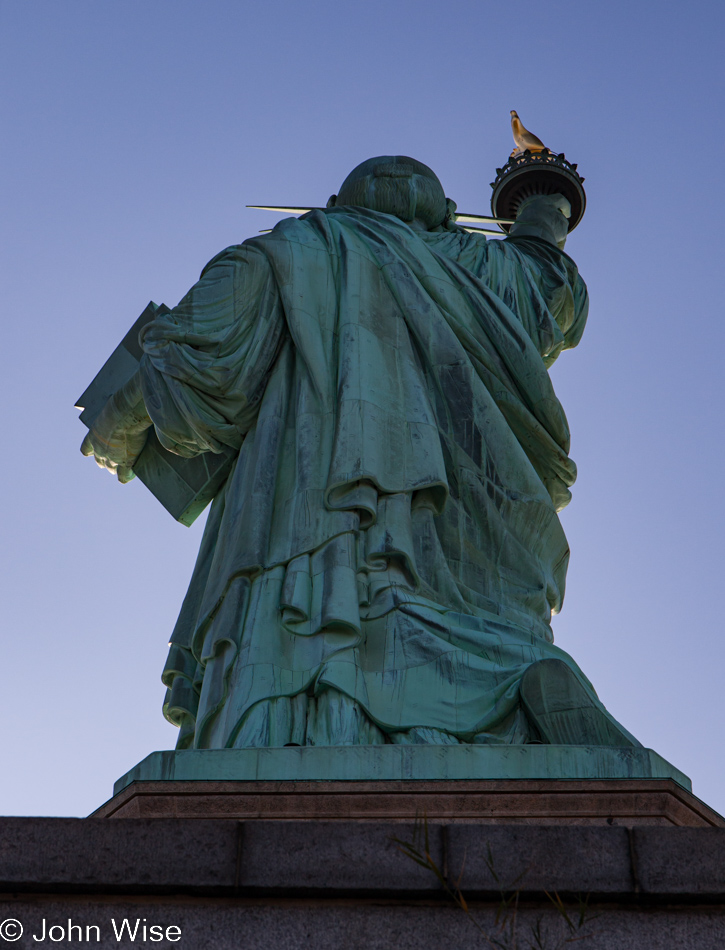
While I have a profound sense of reverence for this statue and what it represents, I am also cursed with an inappropriate sense of irreverence that forces me to follow some unorthodox ideas, such as recognizing that we’ll effectively be crawling up Lady Liberty’s backside.
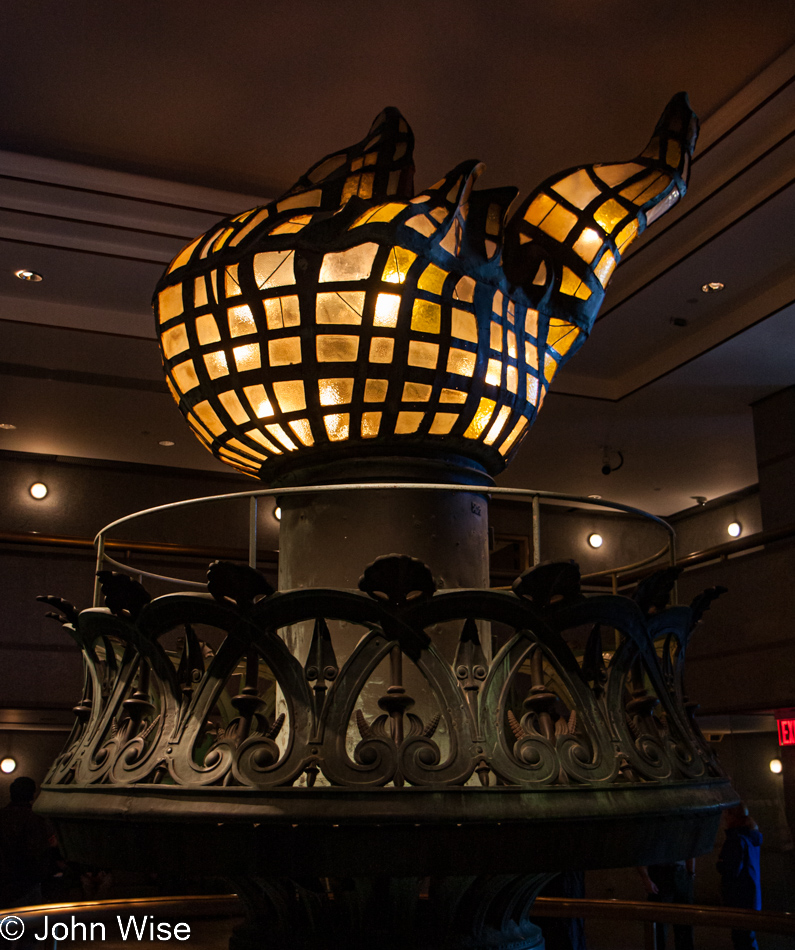
This is the internally lit torch held by the statue for decades. The amber panes of glass and interior lights were early design changes. Then, between 1984 and 1986, when the Statue of Liberty went through a thorough restoration, it was decided to create a new flame that conformed to the original design of Frédéric Auguste Bartholdi, and so a proper 24-karat gold-plated flame was placed in her hand.
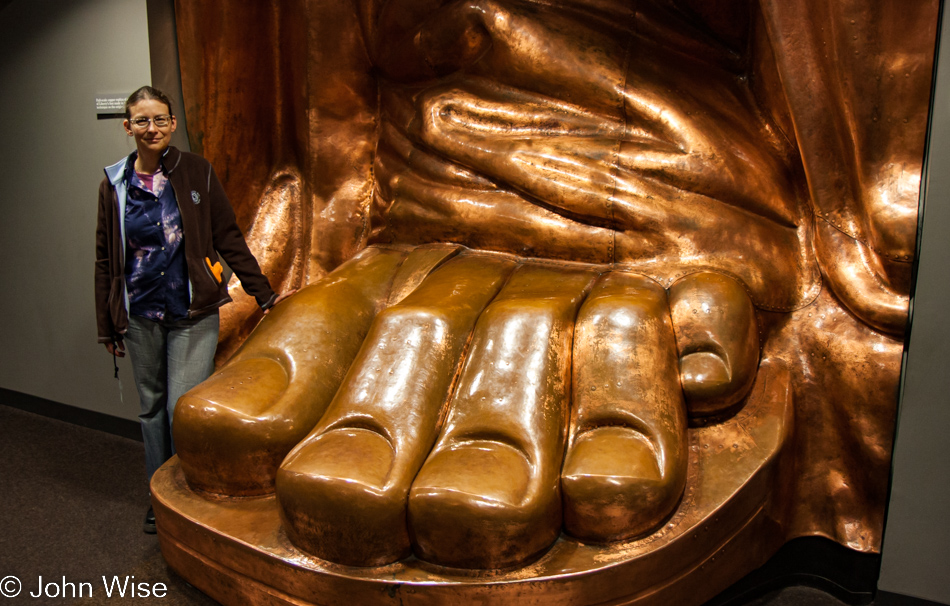
That’s an exact replica of Lady Liberty’s foot in case you ever wanted to compare your head size to one of her toenails.
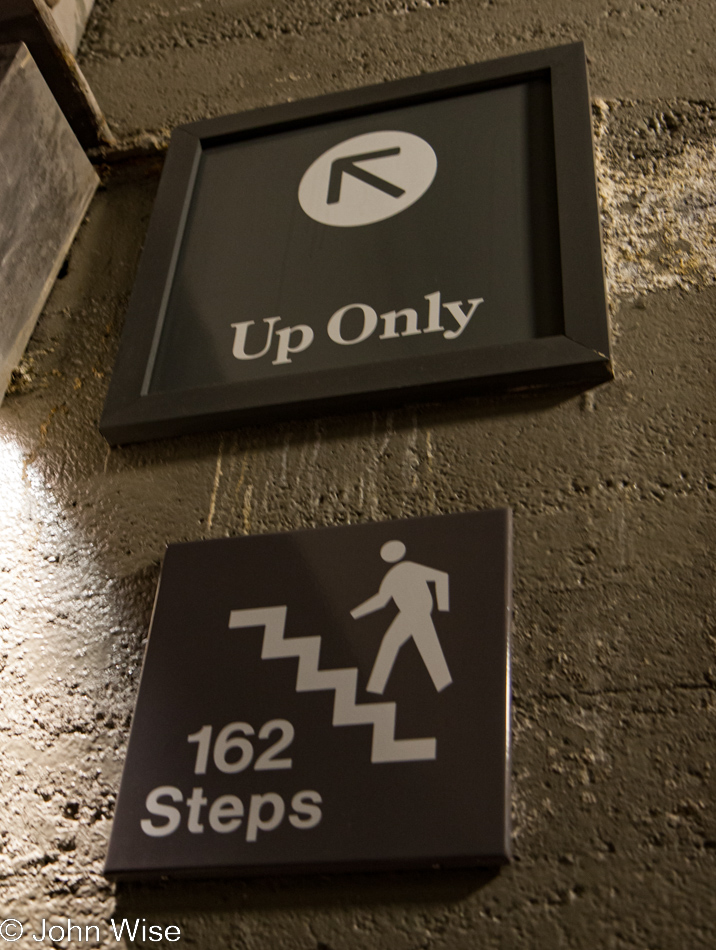
The elevator at the base of the pedestal was not functioning today, so first, we had to ascend 101 feet of stairs before embarking on the final climb up the narrow spiral staircase that took us 22 stories above the pedestal into Lady Liberty’s crown.
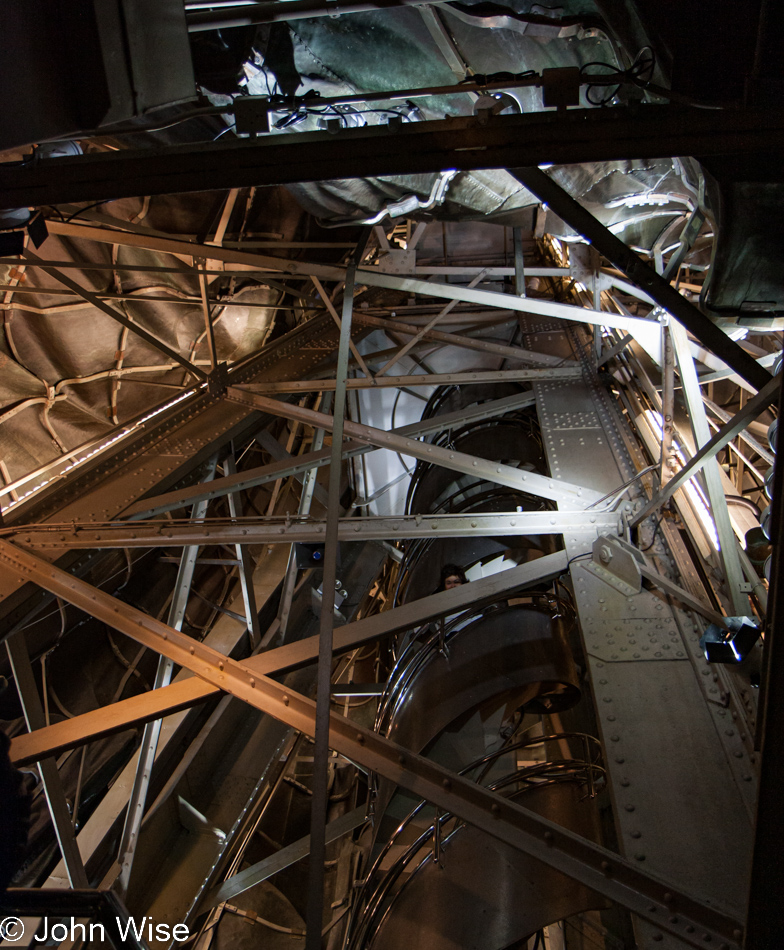
What an amazing idea to be able to visit the interior of a statue and such an iconic one at that. How could any of us be this lucky?
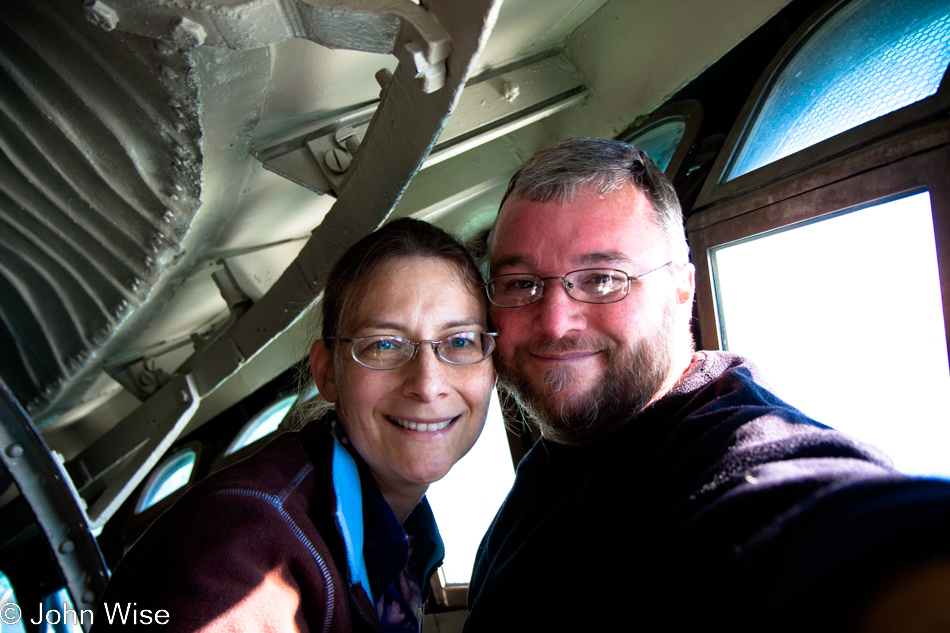
We are not tumors. We are simply visitors in the Statue of Liberty’s head, specifically in the crown. Standing up here, even knocking my head into the steel supports more than once, was just as thrilling as visiting the White House back in May.
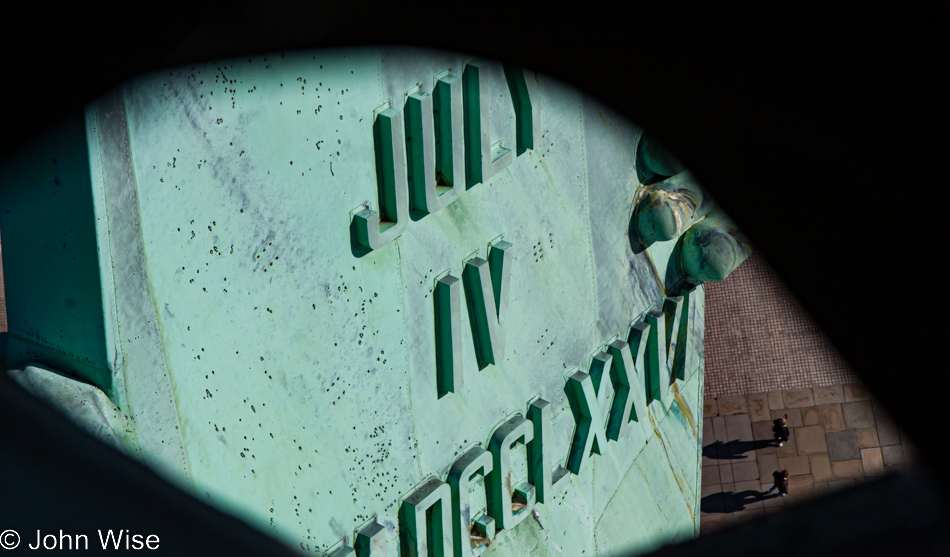
The crown tour opened this past July 4th after being closed for nearly ten years. Tickets were not easy to come by when we ordered back in late June, and after two more years, the statue will once again shut down to visitors as renovations are planned to improve visitors’ ability to visit the crown.
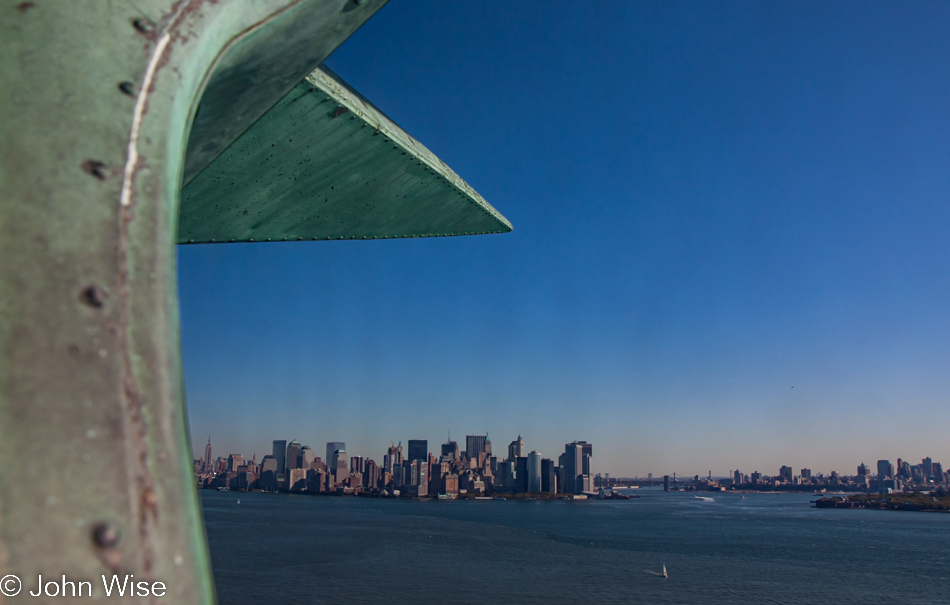
Some anonymous person, back in 1886, was looking out at the Brooklyn Bridge, which had only been open three years by that time. There were no buildings taller than the Trinity Church standing tall at 281 feet (85 meters) and it’s still out there. It would be another 45 years before the Empire State Building at 1,250 feet (381 meters) would really start to redefine the New York skyline.
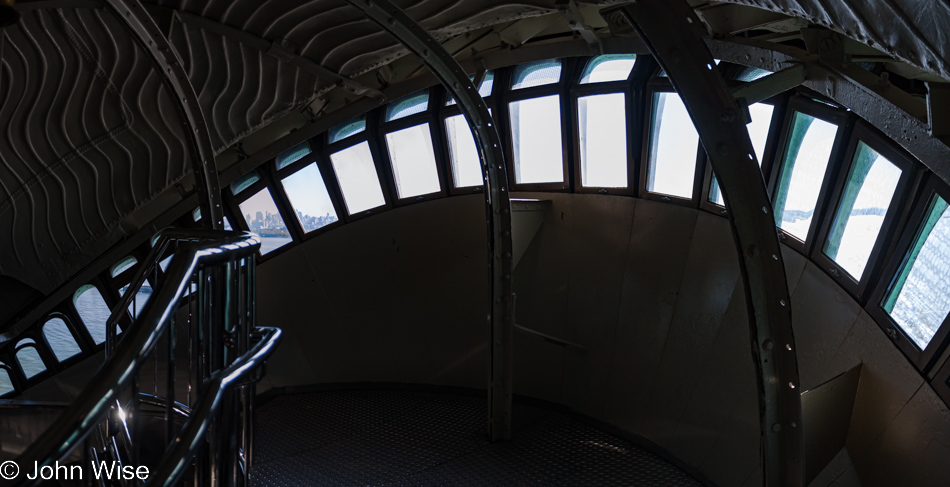
For us tourists, this might be the rarest of views, one in which we are here nearly alone aside from the park ranger who collected our wristbands, and I’m sure must keep watch over those who might feel compelled to carve something into this national treasure.
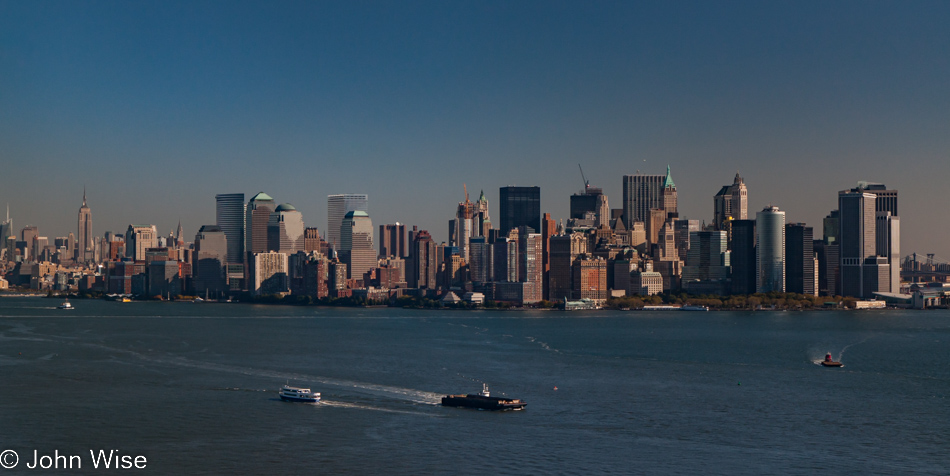
One final look over at the city and we headed for the exit.
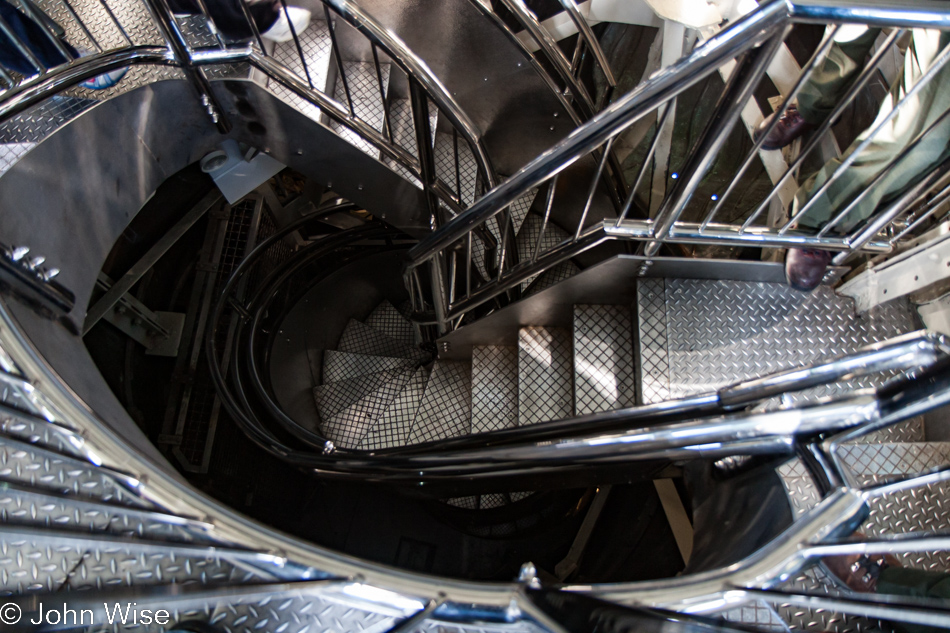
One side is for coming up; the other is for going down while the ranger does their best to perch themself out of the way on the structural frame of the statue. Look in the upper right of this photo, and you can spy the telltale green pants of the National Park ranger. The reason for that is the platform for visitors is rather small here in the crown, which is also why only about 500 people a day get to share the view.
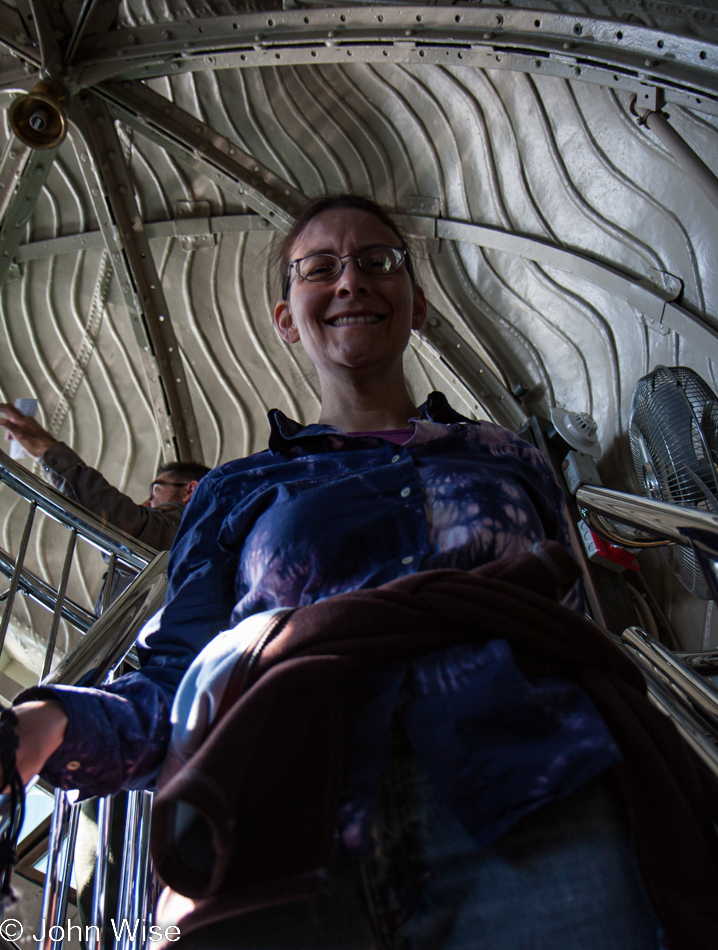
In all, we’ll have climbed about 500 steps to cover both directions. As we are leaving, it is not that we really wanted to go, but others arrived, and I’m certain that they too want to indulge to the best of their ability as space allows them to capture the memories that they, too, at one time in their lives had visited the crown of the Statue of Liberty.
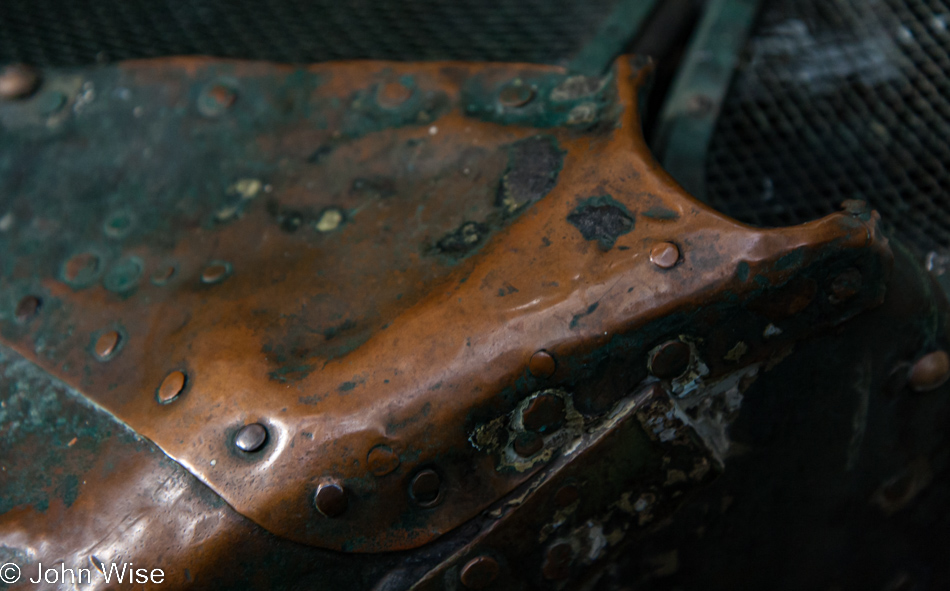
On our descent, we stopped to look at the inside of the Statue of Liberty’s giant nose, and from how polished the copper is, we weren’t the first to reach out and touch this part of history. For a brief moment, I felt like a really big booger.
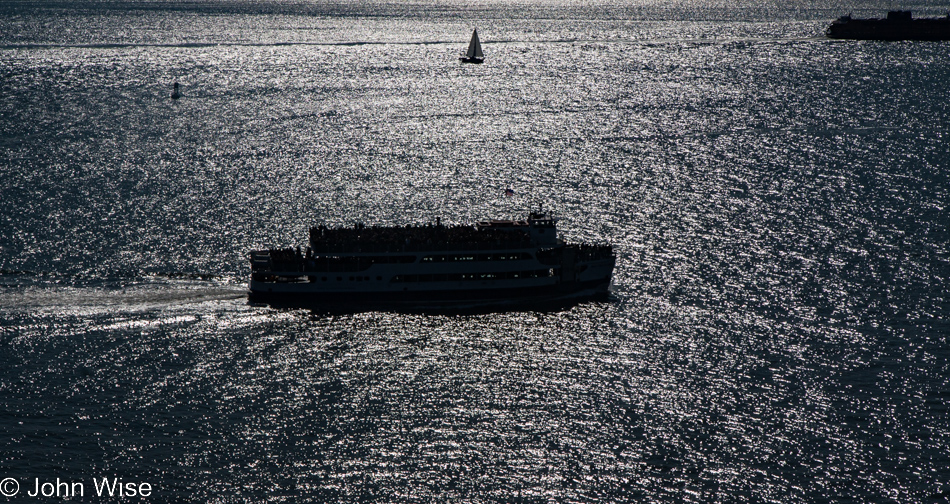
We arrived early this morning, bypassing Ellis Island, as we knew that we’d like to be the first up today, and that’s just what we were offered. Now, with that done, we are visiting the pedestal to check out the views from up here. While it’s difficult to see in this high-contrast image with the ferry in silhouette, there may be a million people on that thing or whatever the carrying capacity of that craft is.
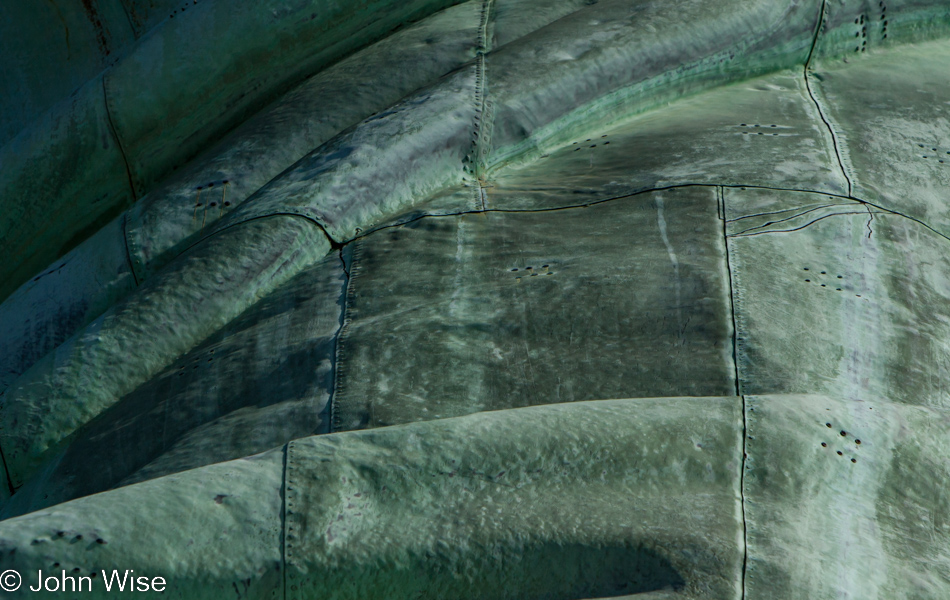
Out of view, next to the left foot of this monument, is a segment of broken chains. In one of the early designs of this statue, she was holding in her left hand the broken shackle that represented the end of slavery in the United States. A terra-cotta model of that version of the statue still exists at the Museum of the City of New York. Ultimately, Lady Liberty would be holding a tablet with the date of July 4th, 1776, when the Declaration of Independence was ratified, but that wasn’t the original idea, and a small part of the broken shackles was able to remain.
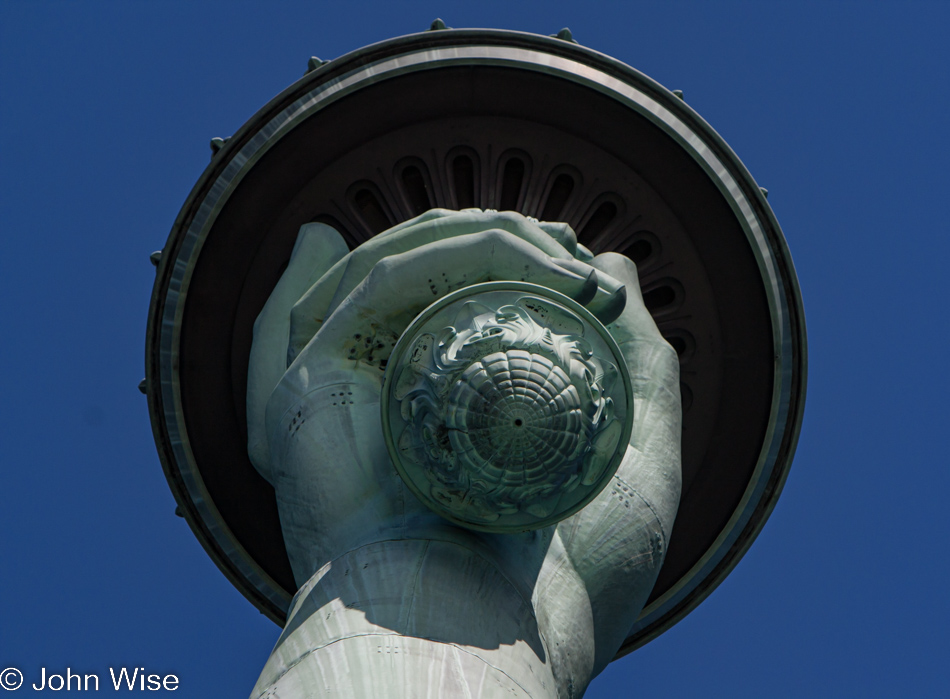
While Frédéric-Auguste Bartholdi was the sculptor of the Statue of Liberty, it was born from an idea by Edouard de Laboulaye. His original idea appears to have been to create a monument to liberty following the end of the Civil War (it should be noted that he was an abolitionist). However, this was deemed “too divisive,” and in keeping with America’s tendency of hiding truths, this connection to the end of slavery and the torch representing the enlightenment from that dark time didn’t fit the narrative of welcoming immigrants, and it was scrubbed from history until 2011 when the L.A. Progressive featured a story about the chains at Lady Liberty’s feet.
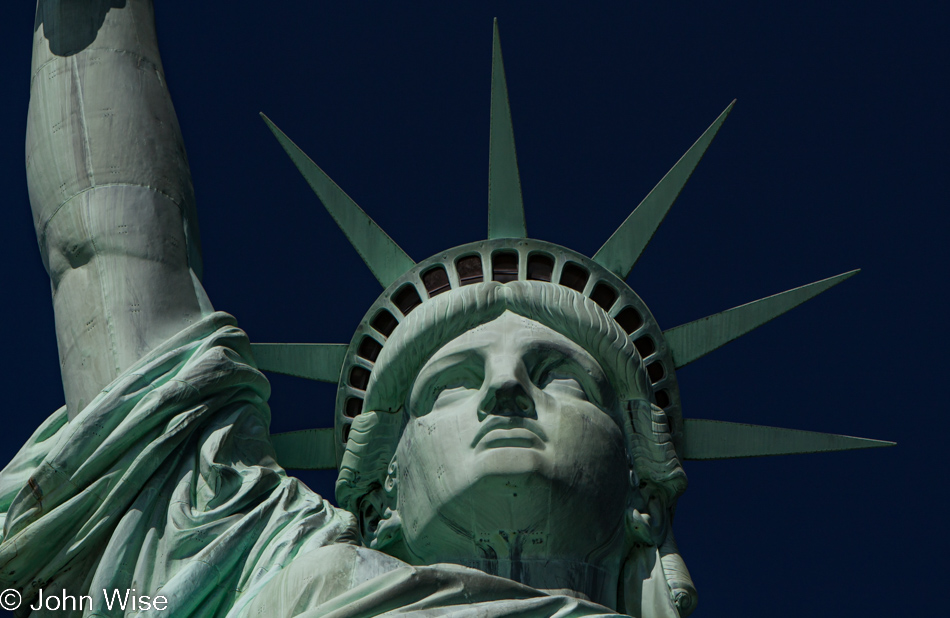
Would a statue celebrating the end of slavery in America have been allowed such a prominent place in our lore had the intolerant underbelly of hate known the truth? She was meant to be a beacon for Americans of African descent, yet here I am in 2022 writing this, and had no idea until this very day as I was researching various aspects of her history. While this is shameful, I’m happy that this journey into the United States has brought me back around and is still teaching me things.
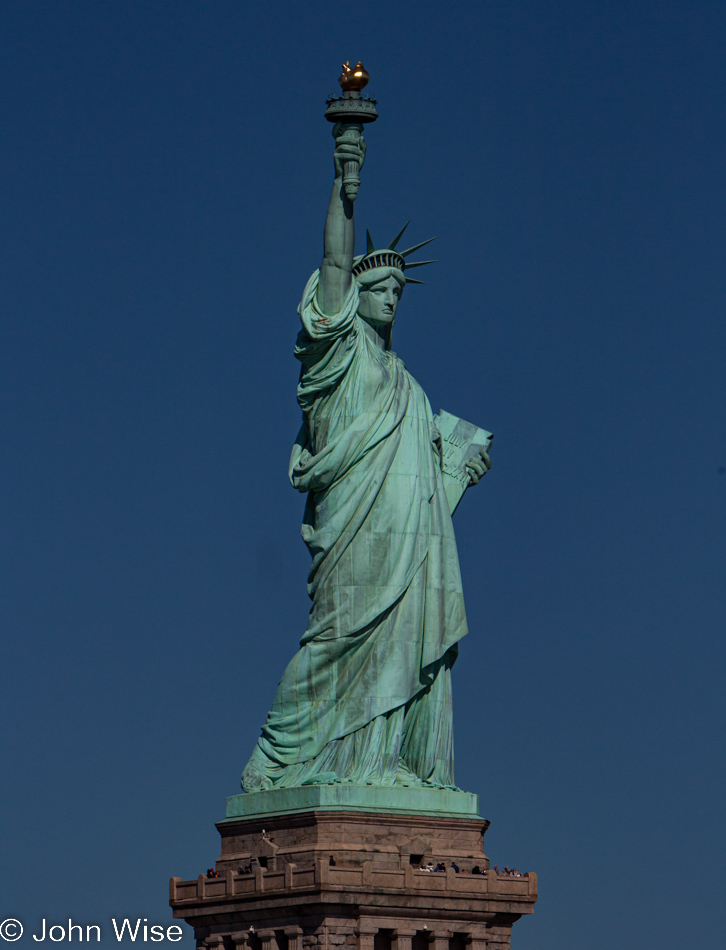
I zoomed into this photo, and sure enough, you can see the chains over her left foot.
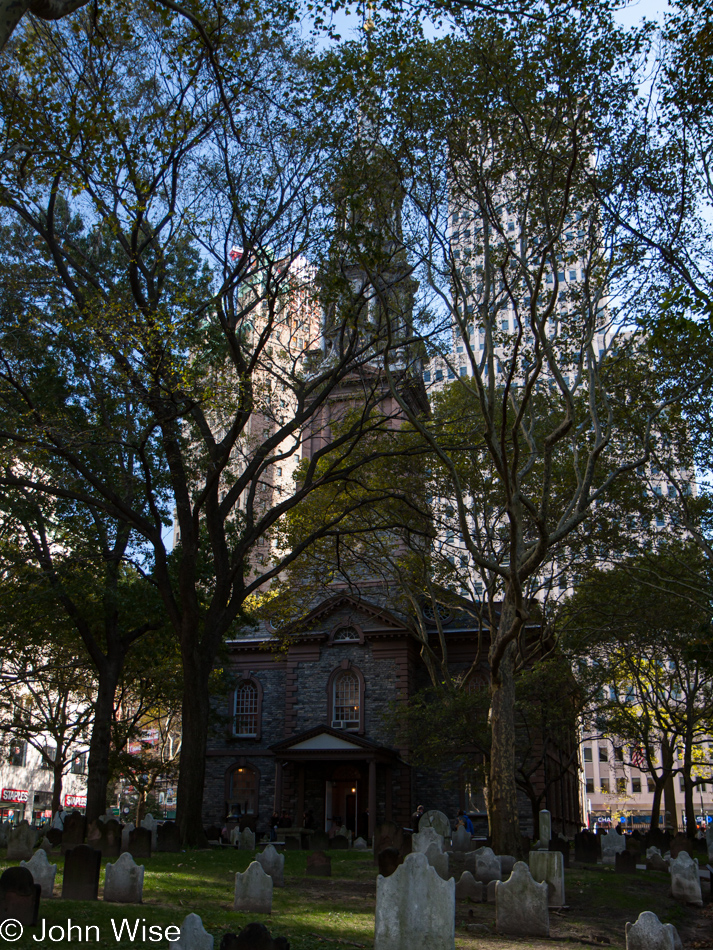
This is St. Paul’s Chapel, which has been standing here since 1766. Why I didn’t photograph the front of this historic building of worship is a mystery, or maybe it was due to the gravestones and trees that in some way removed it from the bustle of the metropolis surrounding it.
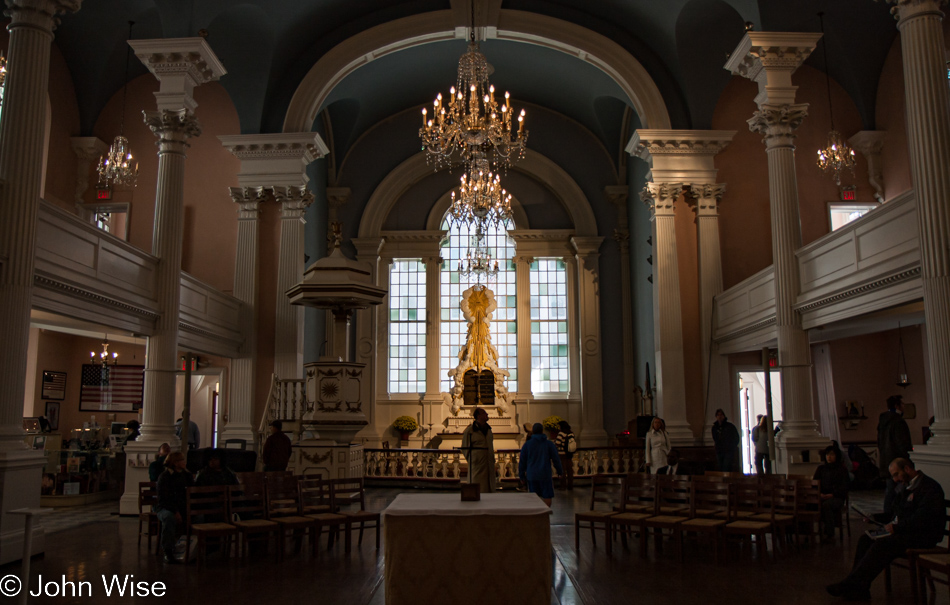
Washington once prayed here.
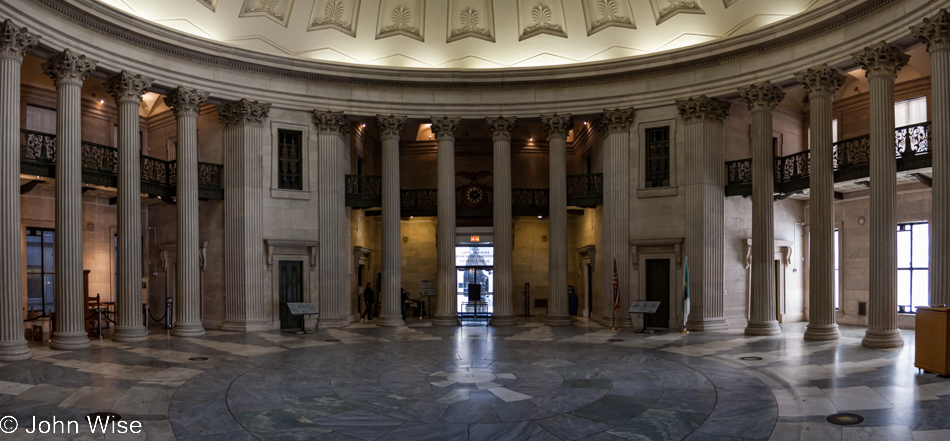
Federal Hall National Memorial is the site where America recognizes its first seat of government as the United States took up residence. For a short time, New York City was the nation’s capital, and the old City Hall that stood here was where George Washington was sworn in. That old building was razed in 1812, and this beauty was built. It, too, was considered for the wrecking ball, but in 1939, it was saved, and shortly thereafter, it became the memorial it is today.
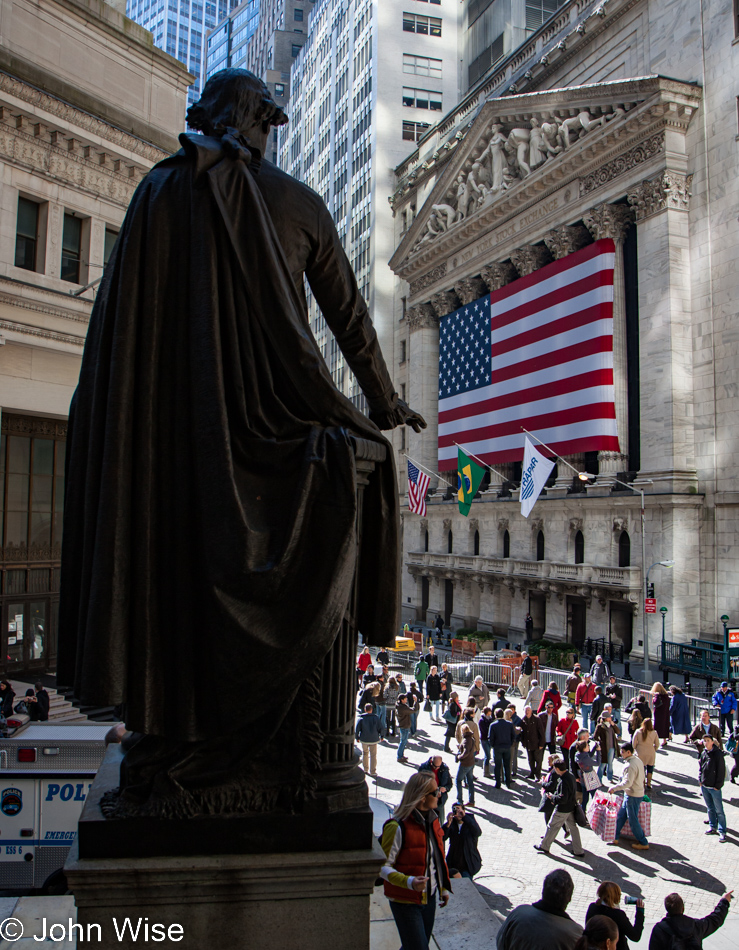
Back when George Washington was inaugurated in this general vicinity, New York City only existed in this part of lower Manhattan. As for this statue looking out at Wall Street, it was made by John Quincy Adams Ward (no relation to the 6th U.S. President with a similar name), who also sculpted one of the most important abolitionist sculptures called the Freedman.
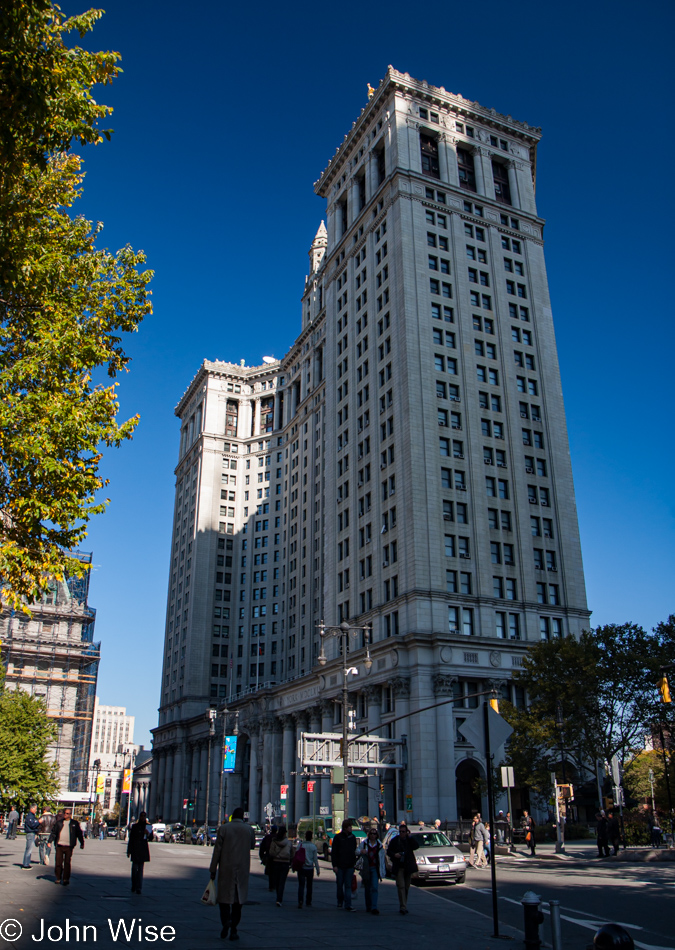
The Manhattan Municipal Building stands on one of the edges where New York City’s governance is now performed. Out of sight is the nearby City Hall that I should have photographed too; it’s the one that replaced the old building over at Wall Street.
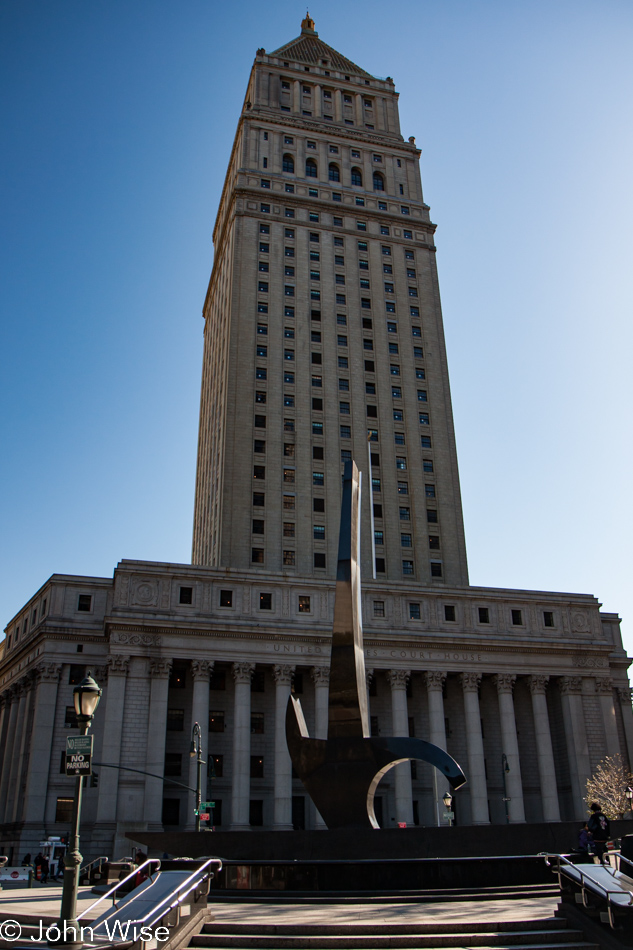
This is the Thurgood Marshall United States Courthouse.
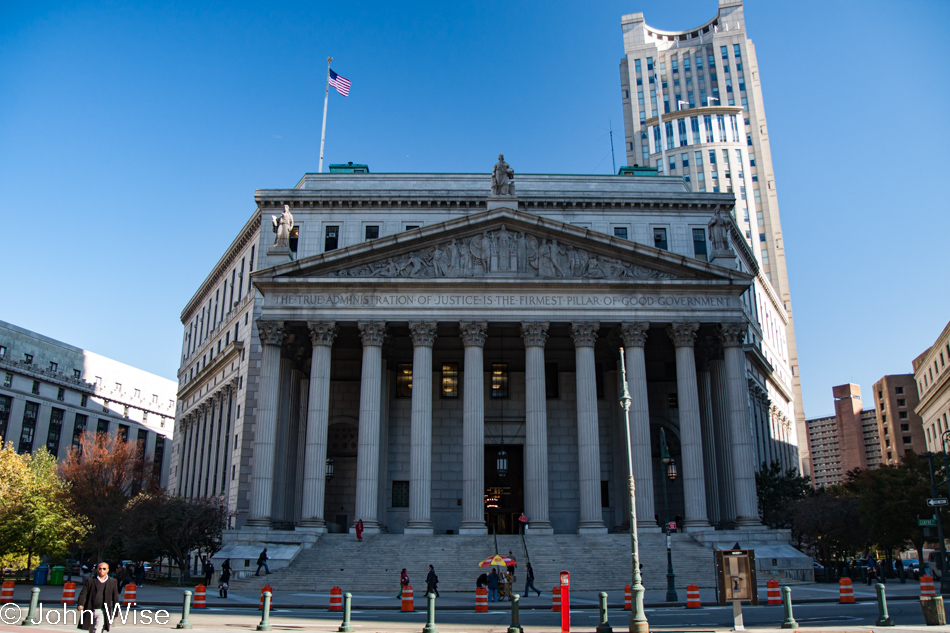
In the background is the Daniel Patrick Moynihan United States Courthouse, where the United States District Court for the Southern District of New York operates. Out front is the New York State Supreme Court Building.
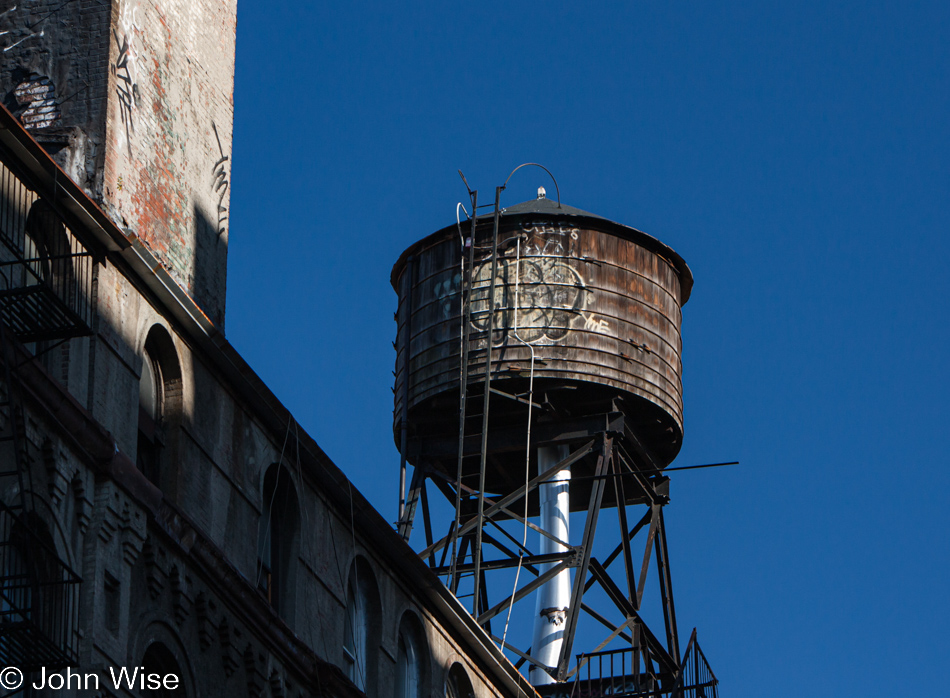
Look across the NYC skyline, and you’ll notice a lot of these old wooden tanks that seem to be relics of the past but are not. They are still in use to this day. It turns out that with so many buildings over seven stories tall, the pressure required to deliver so much water is a Herculean task, and this is where the water tanks come in. Using pumps in the basements of these buildings, water is pumped into the tank and then gravity-fed into the apartments and businesses below. By the way, there’s something about the nature of the wood structure that doesn’t allow the water to freeze in the winter.
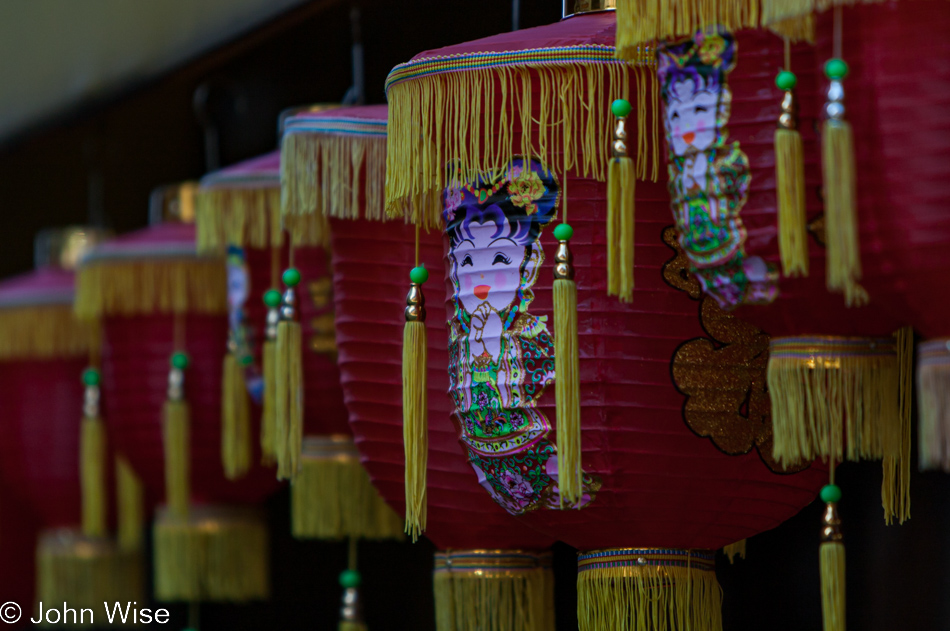
Can you guess the area of the city we are passing through?
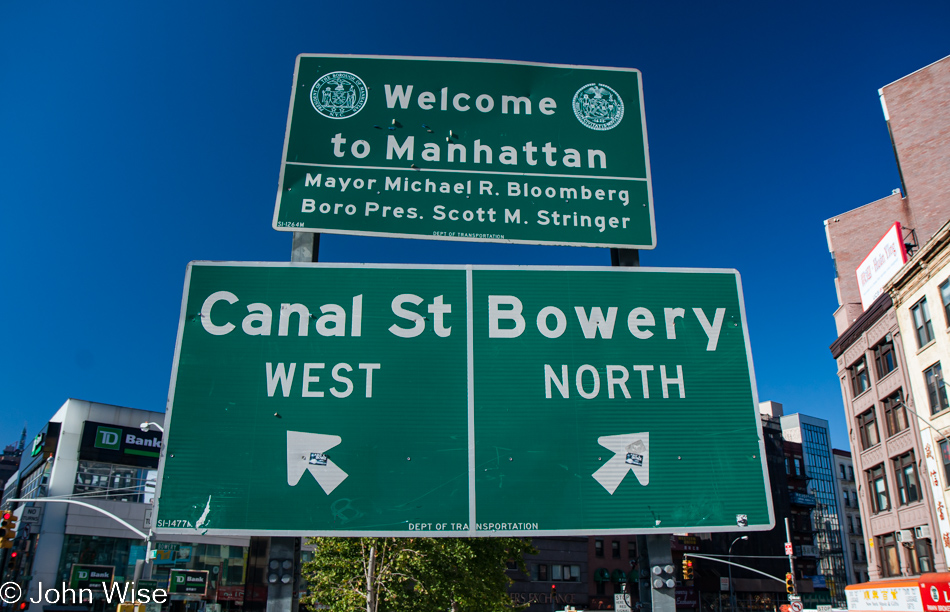
Behind us is the Manhattan Bridge.
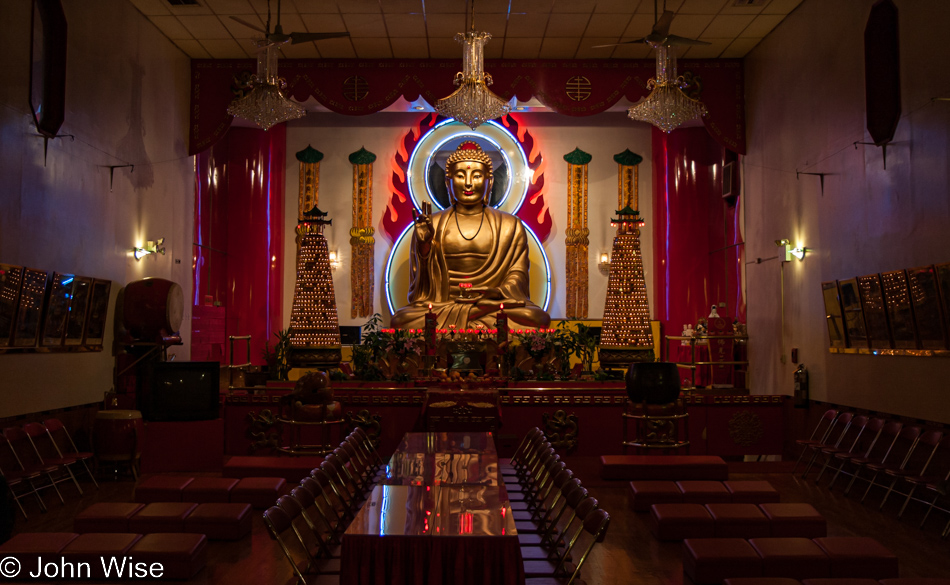
And just to our right from the photo above this one is the Mahayana Buddhist Temple where this photo, which wasn’t allowed to be taken, somehow ended up in my camera in some inexplicable way. Caroline offered a dollar donation for a fortune scroll at the entry, but it was foreboding, telling her not to get too attached to her belongings; this was certainly not a Chinese fortune cookie kind of thing. Of course, she had to offer another dollar, but the Buddhists apparently do not think getting one’s hopes up for great fortune just around the corner is what should be told to strangers.
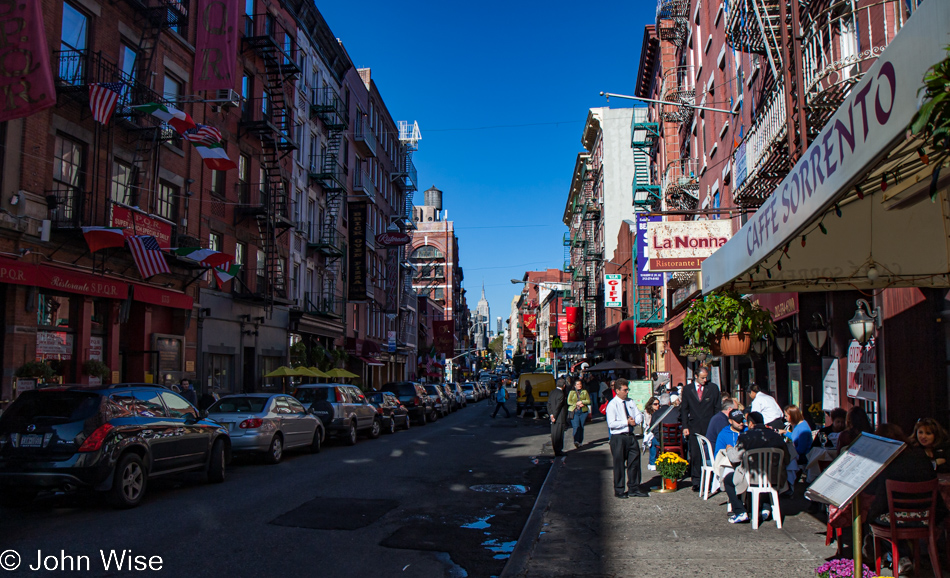
There’s so much to New York City we’ve never experienced, and yet here we are in Little Italy again.
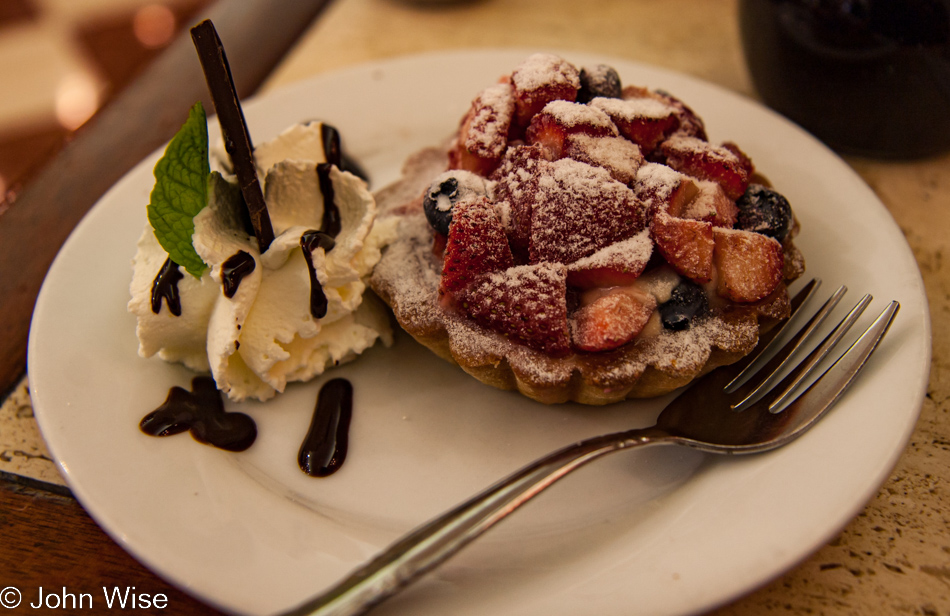
Well, on previous visits, we didn’t take in Café Ferrara, and this experience should rank high on anyone’s visit to the Big Apple…topped with strawberries, powdered sugar, and a drizzle of chocolate.
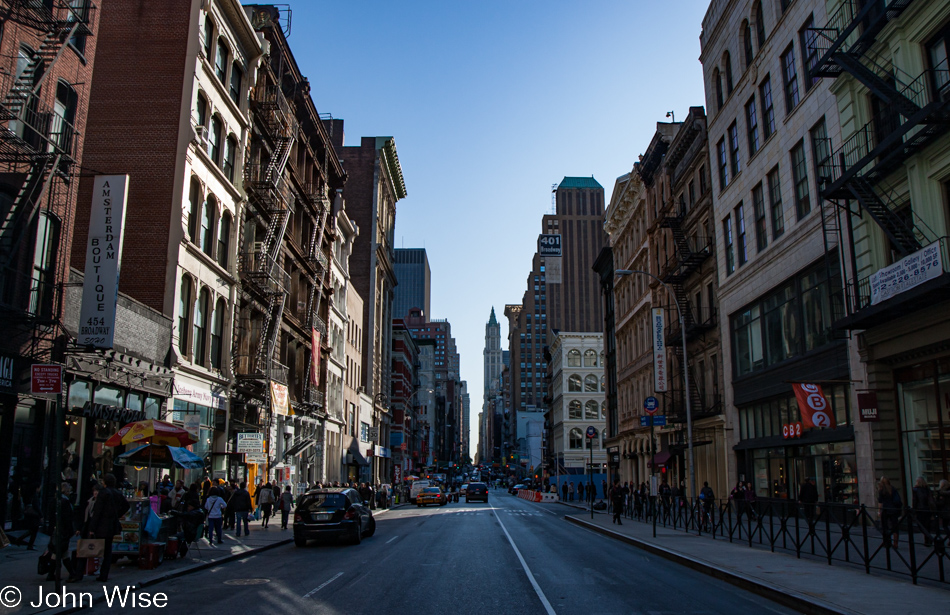
There’s magic in simply walking through this city…
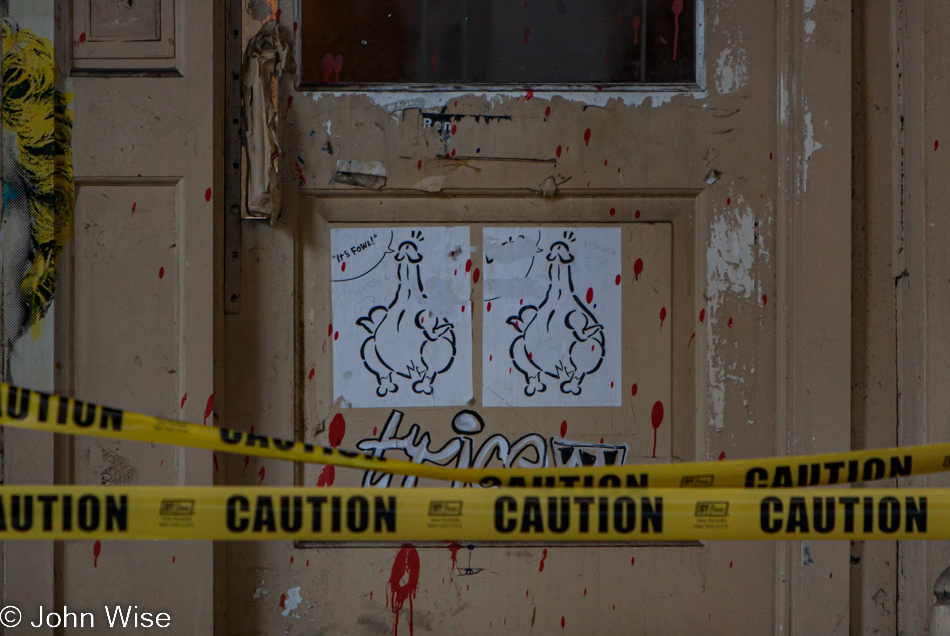
…and then finding something this special because where else might one see chicken dick splattered with blood behind police tape?
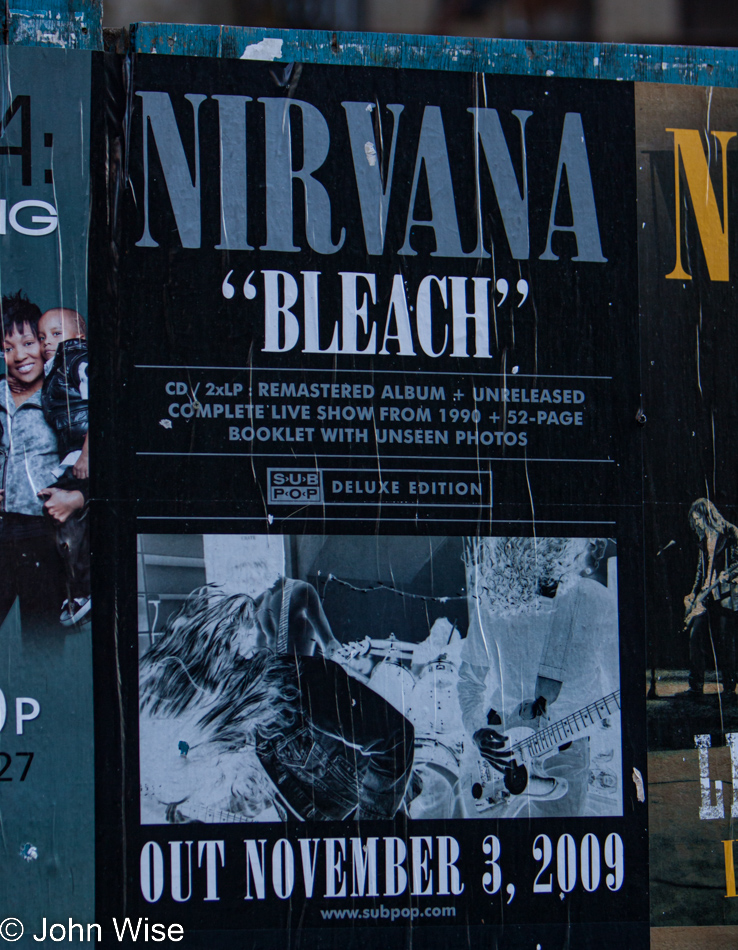
Here’s a funny bit of previously unknown information for my readers: you see on this Nirvana “Bleach” poster and the line about the “Live show from 1990.” Well, that was supposed to be a live show from November 1989 that Caroline and I filmed in Hanau, Germany, but the negotiations of those trying to acquire the videos from us were so bungled on their side that we were never going to come to an amicable deal and so I refused to consider their proposal. This means that our footage, the oldest two-camera footage of Nirvana pre-fame that was shot directly in front of the stage, remains unseen.
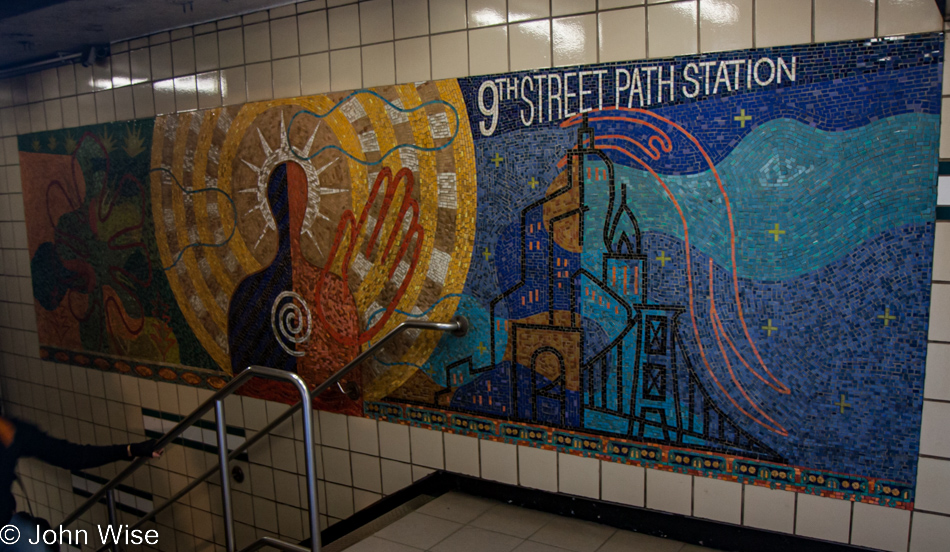
We are at the 9th Street Path Station on our way back to New Jersey to grab the rental car from our hotel, and though it’s not the middle of the night, we have somewhere we need to be.
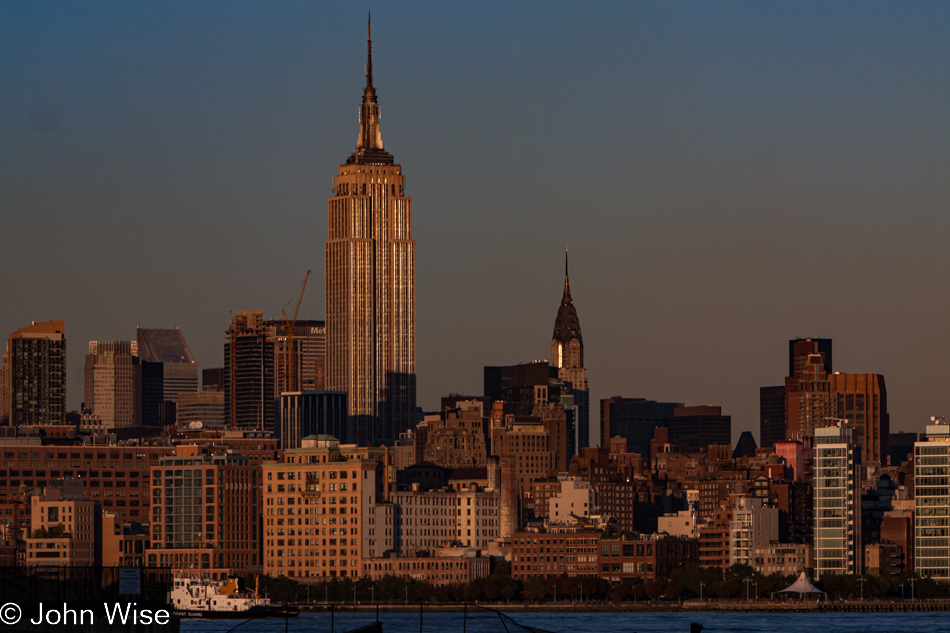
Okay, ready to get going after a moment or two of watching the sunset over New York City.
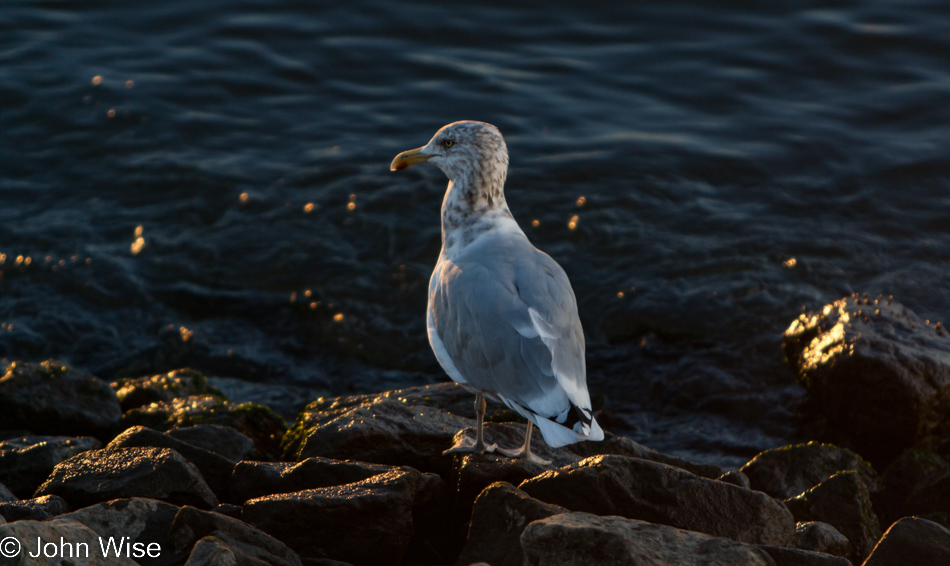
The seagull, too, seemed to be mesmerized.
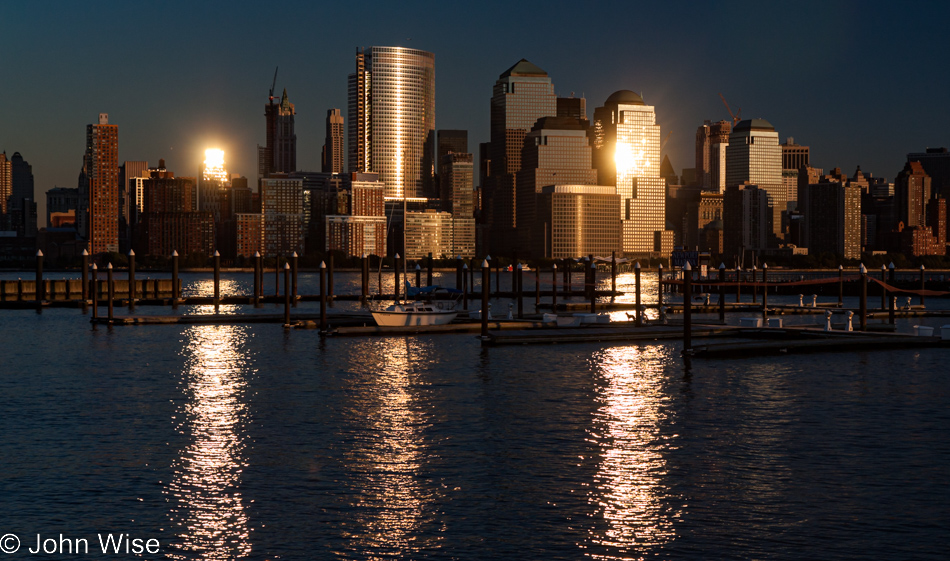
And with this last glistening golden shot, I call it quits on this post. Tomorrow will welcome another adventure.